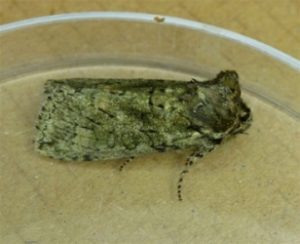Once every four weeks we hold a moth-trapping exercise, using light traps in Marks Hill Wood. As a result, we have built up an increasingly fascinating picture of the moth populations of the wood, discovering a quite remarkable number of rare and scarce species while also getting some useful pointers as to how the woodland reserve should be managed, given the foodplant requirements of the insects.
The Society’s records of butterflies and moths are now substantial, and they tell us a great deal about the changes in the local wildlife and landscape over the past forty years.
New participants in the moth recording sessions are always welcome: we set up our “office” in the woodland on the evenings concerned, with table, chairs, books and beverages, while the insects in the light-traps are regularly checked and brought in for identification before release.
Particular attention is being given to building up detailed records of the wildlife of Marks Hill Reserve, but records are also kept of other parts of the Basildon area, not least those that might come under threat.
We are conscious of the overlap between natural history and human history, not least the history of the landscape, and there are several points of contact with the local historical groups.



